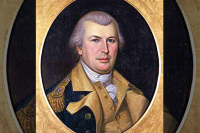James Mooney’s devotion to WNC
For 36 years, from the time he launched his career with the Bureau of American Ethnology in 1885 until his death in 1921, James Mooney devoted his life to detailing various aspects of the history, material culture, oral tradition, language, arts and religion of the Eastern Band of Cherokees, Cheyenne, Sioux, Kiowa, and other tribes, adding a new dimension to the writing of Indian history by combining various methods of research and utilizing sources from the Indians themselves.
Some years ago, I was asked to write a long biographical introduction for a reissue of those two volumes, which was published as “James Mooney’s History, Myths, and Sacred Formulas of the Cherokees (Asheville: Historical Images, 1992). While conducting the research for the project, I was somewhat surprised to discover that Mooney had also written about the folkways of the white culture he observed “on the headwaters of the Tuckaseegee” in Swain and Jackson counties. One of these publications was titled “Folk-lore of the Carolina Mountains” and appeared in volume two of the “Journal of American Folklore” in 1889.
After describing the relative isolation of the region and general living conditions, Mooney went on to catalogue particular folk expressions, customs, and beliefs he had “picked up while engaged on other work.” Here are a few of them.
He was, of course, intrigued by dialect expressions he encountered in a region where “many words obsolete or almost unknown in other sections of the country are still retained.” One such was the word “tolldish,” which Mooney explained was used for “a measure equivalent to one fourth of a peck, and so called because this is the amount deducted as a toll by the miller from a bushel of grain.”
Mooney also noted that, “When one is strong and brave he is said to be ‘much of a man,’ and when he feels sure that he will dislike a new acquaintance he ‘knows in reason that he can’t neighbor him.’”
In regard to the all-important matter of divining just whom a young girl will marry, Mooney recorded three methods: (1) “If a young girl will pluck a white dogwood blossom and wear it in her bosom on a May morning, the first man met wearing a white hat will have the Christian name of her future husband”; (2) “Her handkerchief left out on the grass the previous eve will have his name written upon it in the morning, and from the analogous beliefs in Ireland and elsewhere it is presumable that the writing is done by a snail crawling over it”; and (3) “If she will take a looking-glass to the spring on a May morning, and, turning her back to the spring, look into the mirror, she will see the figure of her lover rise out of the water behind her.”
Mooney heard mountain women say that, “If a dress be begun on Wednesday or Saturday it must be finished the same day, otherwise the maker will never live to wear it.”
On one occasion, he “heard a man say, while looking up at the moon, ‘I see the moon and the moon sees me.’” Himself an Irishman steeped in Irish lore, Mooney noted that this was “part of an old couplet well known in Ireland, the other line of which runs thus, ‘God bless the moon and God bless me.’”
Mooney also recorded a different and perhaps longer version of an old song, “My Pretty Little Pink,” which he “obtained from a lady living on the Oconaluftee River, who had sung it as a child at her old home near Murphy, in the extreme southwestern corner of the state.” His informant only remembered that the song was associated with a children’s game and that the singer, “presumably the ‘pretty little pink,’ stood in the center, while the others marched around her singing the song. She said it had a pretty tune, which she had forgotten, but on coming into the house unexpectedly one afternoon the writer surprised her, singing it in a rich clear voice to the familiar old air of ‘The Girl I Left Behind Me.’” Here is the version Mooney heard in the mountains of WNC sometime in the late 1880s:
My pretty little pink, I once did think
That you and I would marry,
But now I’ve lost all hopes of that,
I can no longer tarry.
I’ve got my knapsack on my back,
My musket on my shoulder,
To march away to Mexico,
To be a gallant soldier.
Where coffee grows on a white oak tree,
And the rivers flow with brandy,
Where the boys are like a lump of gold
And the girls as sweet as candy.”
George Ellison wrote the biographical introductions for the reissues of two Appalachian classics: Horace Kephart’s Our Southern Highlanders and James Mooney’s History, Myths, and Sacred Formulas of the Cherokees. In June 2005, a selection of his Back Then columns was published by The History Press in Charleston as Mountain Passages: Natural and Cultural History of Western North Carolina and the Great Smoky Mountains. Readers can contact him at P.O. Box 1262, Bryson City, N.C., 28713, or at This email address is being protected from spambots. You need JavaScript enabled to view it..





